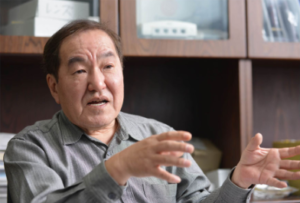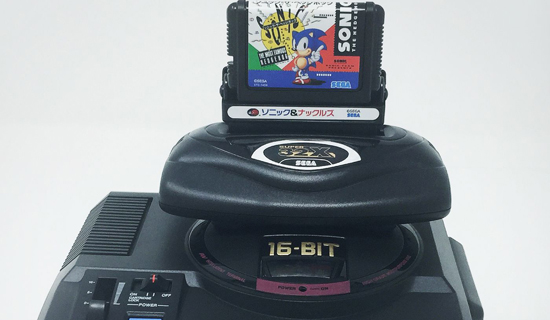Hideki Sato (Former Sega President)

He had a key role in the development of every piece of hardware from the time he was a part of Sega’s Consumer Division, to the time he left the company. These days he’s left the games industry, and serves as the president of Advance Create. They deal primarily with the development and manufacturing of various types of lighting products, used on highways and such.
The Mega Drive was Sega’s best selling ever piece of hardware overseas as the Genesis, where it was a huge hit. However its market share in Japan was rather lacking. We asked former Sega president Hideki Sato, who was a key person in the development team, to talk to us about the reasons why that was, and to share some previously untold stories.
The Desire to “Overthrow Nintendo” That Went Into the Mega Drive
I get the impression that the direction of hardware development for the Mega Drive changed completely from before to after, but what was the concept that was originally planned for the Mega Drive?
(Sato) To put it simply, we wanted to make a game system that would defeat Nintendo. The SG-1000, which was the first home console that we released in 1983, sold 160,000 units. For a company like Sega that had always been making at most thousands of an arcade game, regardless of sales, this was an unbelievable number. Even though it wasn’t able to compete with the Famicom, which went on sale the same day. We Sega employees went to department stores to see the product display and customer reactions that day, and saw the Famicom flying off the shelves with our own eyes. Maybe about one in ten people bought the SG-1000.
What did you attribute that difference to?
(Sato) I thought it was down to the difference in software. Honestly, the quality of the software for the SG-1000 was not very high. That’s because home console gaming felt more like a secondary thing within the company, at that time. In-house development teams didn’t really work on it. Most of the software was outsourced, and just couldn’t touch Nintendo’s high quality software.
And that’s why you thought to improve the software on the next hardware platform, right?
(Sato) That’s right. Because we came to understand that home console gaming was our business too, thanks to the SG-1000. Nonetheless, at the time it was rather difficult to suddenly make new titles for a next generation system one of our pillars. So we worked out the concept of being able to play existing hit arcade games at home, and begun development on our next generation of hardware.
I see.
(Sato) However, a 16-bit CPU was necessary for porting these arcade games (The Famicom had an 8-bit CPU). We decided to design the hardware around the MC6800, a processor that was used in arcade games…but that was expensive. Using those kind of parts shot up the cost of the system, so then we were faced with the problem of it being too expensive for a home console.
I didn’t get the impression that the Mega Drive was that expensive of a piece of hardware…
(Sato) Actually, we negotiated so that the CPUs were sold to us at 1/10 their normal cost. We told them that if they’d sell them to us at the price we were asking, we’d buy 300,000 of them all at once. Then we kept pushing, saying that if they could do even better we’d buy 500,000…1,000,000…. And somehow we negotiated with them to do that.
To think that happened behind the scenes during the development of the Mega Drive!
(Sato) Right. That’s how we kept the cost down, and brought about hope for it being a home console. However, our greed showed itself yet again….No matter what, we didn’t want the Mega Drive to be just another game console. In order to respond to the growing demands of modern media, we added all sorts of expansion ports.
That was the right call to make.
(Sato) When we saw that the PC Engine was unbelievably going to be using a high capacity CD-ROM, we believed that the demand for a CD-ROM would increase later on. Actually, the area around the cartridge slot part of the system has a disk-shaped design with the CD-ROM in mind.
I had no idea that was the thought process behind that design.
(Sato) We also tried to make it so that it supported karaoke, which was very popular at the time…we tried to give it a floppy drive to give it media capabilities…We were set on making it usable for all sorts of different purposes, and that’s why we put “AV Intelligent Terminal” and “High Grade Multipurpose Use” on the system.
Both of those were definitely written on early model Mega Drive consoles!
(Sato) In particular, we put a lot of effort into connectivity from that point on. By connecting a modem you can compete with people in other areas…those are the kinds of things we were thinking about. Even though that’s become a commonplace thing today (Laughs)
Considering your planning for the future and the power of the machine itself, the Mega Drive was a piece of hardware very ahead of its time. The Super Famicom would go on sale 2 years later in 1990, but in terms of raw power I got the impression that it had advantages and disadvantages.
(Sato) That’s true. There have been times when I wondered whether or not we should have gone to market first or not. Because any new hardware that comes out afterward is going to be seen as better, no matter what. If Sega had the strong sales structure that Nintendo did, we might have been able to keep our lead. But unfortunately, Sega had barely any knowledge as to how to distribute a home game console very well at that point. And as a result we allowed Nintendo to establish a huge lead.
Surpassing Nintendo in the North American Market, By Making Sonic a Big Hit!
Sonic The Hedgehog was a big hit worldwide in 1991. Please tell us any particularly interesting stories that you may have from that time.
(Sato) Before the release of Sonic, we’d been trying to develop games with a similar feel that would surpass Super Mario Bros. However, they all ended up being number two in the end. We weren’t able to surpass the original. But Sonic was created with a completely different approach, one focusing on speed. The man in charge of marketing for Sega of America at the time, Al Nilsen, really liked this idea. He said that he wanted to put all of the advertising budget into Sonic, and he also proposed advertising that directly compares Sega to its competitors. Saying bad things about your competitors wasn’t the type of thing that worked with Japanese sensibilities, but there it was a commonly used technique. That advertising ended up being very popular, and Sonic was a big hit. I don’t think Sonic would have turned into as big of a title as it was, if not for Al Nilsen.
Having such a bold commercial really worked out.
(Sato) Right. Within Japan there wasn’t very much fervor, but in North America Sonic was packed in with the console. So the Genesis overtook Nintendo for the number one hardware spot. That was the first time we’d ever won against Nintendo (Laughs). Many third parties came on board after seeing our success in America, and it turned into an advantageous situation for us. But we were competing with big companies like Namco and Konami in arcades domestically, so we couldn’t commit all of our energy to either one. I think that’s another primary factor in the Mega Drive not performing in Japan.
So that was a factor as well…
(Sato) There was another factor too. The fact that Sega itself made so many games specifically for arcades may have been ultimately damaging. At any rate, we’d try to take care of the most important genres ourselves, and rely on third parties to make games for the others. It probably would have been better if we could have sold just based on our own software alone like Nintendo, but unfortunately Sega’s software just didn’t have that kind of power.
I think I’ve come to understand the reasons why the Mega Drive struggled domestically. However, with the Genesis’ success in America, certainly you would have made a profit?
(Sato) We definitely made a profit. But…
But…?
(Sato) Later on, we were selected to partner with PC maker IBM Japan to create a piece of hardware called the TeraDrive. At that time PCs were expensive and not necessarily user-friendly, so they needed a plan to get more of them into homes. Thinking that in order to promote this to young people who would be more likely to use a PC, they needed to make them have more of an entertainment aspect. With that in mind, Sega was selected for having had such a big hit in the Genesis. At that stage of planning, there was a rather lofty goal of selling 1,000,000 units at 200,000 yen a piece, to make 200,000,000,000 yen….but it didn’t go so well (Laughs bitterly)
Did you put some of the profits made from the Mega Drive into the development of the TeraDrive?
(Sato) That’s right. Due to various circumstances, the TeraDrive didn’t sell very well. And its failure resulted in a huge monetary loss.
And with the Mega Drive having turned such a profit too! But that makes for a very Sega-like story… (Laughs)

